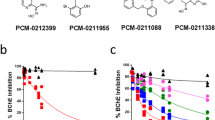Abstract
The effect of the neurotoxicant, 1-methyl-4-phenylpyridinium ion (MPP+) on acetylcholinesterase (AchE) activity was investigated. The MPP+ was found to inactivate the enzyme in a dose dependent manner. The kinetic parameter, Km for the substrate (acetylthiocholine), was found to be 0.216 mM and Ki for MPP+ for the inactivation of AChE was found to be 0.197 mM. It was found that MPP+ is neither a substrate of AChE nor the time-dependent inactivator. The studies of reaction kinetics indicate inactivation of AChE to be a linear mixed-type inhibition. The inactivation of AChE by MPP+ was partially recovered by either dilution or gel exclusion chromatography. These data suggest that once MPP+ enters the basal ganglia of the brain, it can inactivate the AChE and thereby increase the acetylcholine level in the basal ganglia, leading to potential cell dysfunction. It appears likely that the nigrostriatal toxicity by MPP+ leading to Parkinson's disease-like syndrome may, in part, be mediated via the AChE inactivation.
Similar content being viewed by others
References
Burnhan WM: Drugs acting on the basal ganglia. In: Principles of Medical Pharmacology. B.C. Decker Inc., Philadelphia, 1989, pp 198–202
Francis GS: Modulation of peripheral sympathetic nerve transmission. J Am Coll Cardiol 12:250–254, 1988
Flattery KV, Spero L: Autonomic nervous system neurotransmitters. In: Principles of Medical Pharmacology. B.C. Decker Inc., Toronto, Philadelphia, 1989, pp 198–202
Ballinger J-C, Levy-Serpier J, Debord J, Penicaut B: Acetylcholinesterase inhibition by two phosphoric 4-nitroanilides. J Enz Inhib 3:211–217, 1990
Fest C, Schmidt KJ: The chemistry of organophosphorus pesticides. Springer Verlag, Berlin-Heidelberg, 1973
Eto M: Organophosphate pesticides: Organic and biological chemistry, Cleveland. The Chemical Rubber Company, 1979
Langston JW, Ballard P, Tetrud JW, Irwin I: Chronic parkinsonism in humans due to a product of meperidine-analog synthesis. Science 219:979–980, 1983
Burns RS, Chiueh CC, Markey SP, Ebert MH, Jacobowitz DM, Kopin IJ: A primate model of parkinsonism: selective destruction of dopaminergic neurons in the pars compactra of the substantia nigra by N-methyl-4-phenyl-1,2,3,6-tetrahydropyridine. Proc Natl Acad Sci USA 80:4546–4550, 1983
Heikkila RE, Manzino L, Cabbat FS, Duvoisin RC: Protection against the dopaminergic neurotoxicity of 1-methyl-4-phenyl-1,2,3,6-tetrahydropyridine in mice. Nature (London) 311:467–469, 1984
Langston JW, Irwin I, Langston EB, Forno LS: 1-methyl-4-phenylpyridinium ion (MPP+): Identification of a metabolite of MPTP, a toxin selective to the substantia nigra. Neurosci Lett 48:87–92, 1984
Chiba K, Trevor A, Castagnoli N: Metabolism of the neurotoxic amine, MPTP, by brain monoamine oxidase. Biochem Biophys Res Commun 120:574–579, 1984
Chiba K, Peterson LA, Castagnoli KP, Trevor AJ, Castagnoli NE Jr Studies on the molecular mechanism of bioactivation of the selective nigrostriatal toxin 1-methyl-4-phenyl-1,2,3,6-tetrahydropyridine. Drug Metab Dispos 13:342–347, 1985
Gessner W, Bross A, Shen R-S, Abell CW: Further insight into the mode of action of the neurotoxin 1-methyl-4-phenyl-1,2,3,6-tetrahydropyridine (MPTP). FEBS Lett 183:345–348, 1985
Heikkila RE, Cabbat FS, Manzino L, Duvoisin RC: Effect of 1-methyl-4-phenyl-1,2,3,6-tetrahydropyridine on nigrostriatal dopamine in mice. Neuropharmacol 23:711–713, 1984
Salach JI, Singer TP, Castagnoli N Jr, Travor A: Oxidation of the neurotoxic amine 1-methyl-4-phenyl-1,2,3,6-tetrahydropyridine (MPTP) by monoamine oxidases A and B and suicide inactivation of the enzymes by MPTP. Biochem Biophys Res Commun 125: 831–825, 1984
Youdim MBH, Finberg PM: New directions in monoamine oxidase A and B selective inhibitors and substrates. Biochem Pharmacol 41:155–162, 1991
Castagnoli N Jr, Sparatore A, Ottoboni S, Leung L, Trevor A: Mechanistic studies on the MPTP inactivation of MAO-B. 10th Intl. Congress of Pharmacology. M.J. Rand and C. Raper (eds), 1987, pp 875–878
Lewin R: Brain enzyme is the target of drug toxin: A chemical known as MPTP causes a Parkinson-like state in humans and monkeys; biochemical and autoradiographical studies are closing in on the mechanism. Science 225:1460–1462, 1984
Riederer P, Jellinger K, Seemann D: In: KF Tipton, P Dostert, M Strolin Benedetti (eds) Monoamine oxidase and disease. Prospects for therapy with reversible inhibitors. Academic Press, New York, 1984, pp 403–415
Ellman GL, Courtney KD, Andres V Jr, Featherstone RM: A new and rapid colorimetric determination of acetylcholinesterase activity. Biochem Pharmacology 7:88–95, 1961
Ellman GL: Tissue sulfhydryl groups. Arch Biochem Biophys 82: 70–77, 1959
Branchini BR, Lajiness E: Inactivation of acetylcholinesterase with a bretylium tosylate photoaffinity probe. Biochim Biophys Acta 884:135–141, 1986
Dixon M, Webb E, Thorne CJR, Tipton KF: Enzyme inhibition and activation. In: Enzymes. Academic Press, New York, 1979, pp 332–467
Ghag S, Wright A, Moudgil VK: Inactivation of rat brain acetylcholinesterase by pyridoxal 5′-phosphate. Biochim Biophys Acta 881:30–37, 1986
Segel IH: Enzyme inhibition. In: Biochemical Calculations. Published by John Wiley & Sons, Inc., 1976, pp 246–272
Wecker L, Laskowski MB, Dettbarn WD: Neuromuscular dysfunction induced by acetylcholinesterase inhibition. Fed Proc 37: 2818–2822, 1978
Kuhn DE, Logan DM, Rathbone MP: Altered acetylcholinesterase isozyme patterns in mice with hereditary muscular dystrophy. J Exp Zool 216:213–233, 1981
Bonham JR, Gowenlock AH, Timothy JA: Acetylcholinesterase and butyrylcholinesterase measurement in the pre-natal detection of neural tube defects and other fetal malformations. Clin Chim Acta 115:163–170, 1981
Soininen H, Halonen T, Riekkinen PJ: Acetylcholinesterase activities in cerebrospinal fluid of patients with senile dementia of Alzheimer type. Acta Neurol Scand 64:217–224, 1981
Ramsay RR, Salach JI, Singer TP: Uptake of the neurotoxin 1-methyl-4-phenylpyridine (MPP+) and its relation to the inhibition of mitochondrial NADH-linked substrates by MPP+. Biochem Biophys Res Commun 134:743–747, 1986
Ramsay RR, Salach JI, Dadgar J, Singer TP: Inhibition of mitochondrial NADH dehydrogenase by pyridine derivatives and its possible relation to idiopathic Parkinsonism. Biochem Biophys Res Commun 135:269–274, 1986
Ramsay RR, McKeowown KA, Johnson EA, Booth RG, Singer TP: Inhibition of NADH oxidation by pyridine derivatives. Biochem Biophys Res Commun 146:53–57, 1987
Ramsay RR, Youngster SK, Nicklas WJ, McKeown KA, Jin Y-Z, Heikkila RE, Singer TP: Structural dependence of the inhibition of mitochondrial respirtion and of NADH oxidase by 1-methyl-4-phenylpyridinium (MPP+) analogs and their energized accumulation by mitochondria. Proc Natl Acad Sci USA 86:9168–9172, 1989
Spinedi A, Pacini L, Limatola C, Luly P, Farias RN: A study of human erythrocyte acetylcholinesterase inhibition by chlorpromazine. Biochem J 278:461–463, 1991
Stoops JK, Bender ML: A spectrophotometric assay for determining the rate constants of acetylcholinesterase inhibitions. Anal Biochem 63:543–554, 1975
Vallette FM, Marsh DJ, Muller F, Massoulie J: Comparative affinity chromatography of acetylcholinesterase from five vertebrate species. J Chromatog 257:285–296, 1983
Edwards JA, Brimijoin S: Thermal inactivation of the molecular forms of acetylcholinesterase and butyrylcholinesterase. Biochim Biophys Acta 742:509–516, 1983
Das YT, Brown HD, Chattopadhyay SK: Microcalorrimetric determination of binding sites of acetylcholinesterase. Biochim Biophys Acta 745:107–110, 1983
Forberg A, Puu G: Kinetics for the inhibition of acetylcholinesterase from the electric eel by some organophosphates and carbamates. J Biochem 140:153–156, 1984
De Jong LPA, Kossen SP: Stereospecific reactivation of human brain and erythrocyte acetylcholinesterase inhibited by 1,2,2-trimethylpropyl methylphonofluoridate (soman). Biochim Biophys Acta 830:345–348, 1985
Kovach IM: Structure and dynamics of serine hydrolase-organophosphate adducts. J Enz Inhib 2:199–208, 1988
Ennis M, Shipley MT: Tonic activation of locus coeruleus neurons by systemic or intracoerulear microinjection of an irreversible acetylcholinesterase inhibitor: increased discharge rate and induction of C-fos. Exper Neur 118:164–177, 1992
Sidek HM, Nyquist-Battie C, Vanderkooi G: Inhibition of synaptosomd enzymes by local anesthetics. Biochim Biophys Acta 801:26–31, 1984
Spinedi A, Pacini L, Luly P: A study of the mechanism by which some amphiphilic drugs affect human erythrocyte acetylcholinesterase activity. Biochem J 261:569–573, 1989
Spinedi A, Pacini L, Limatola C, Luly P, Farias RN: Phenothiazines inhibit acetylcholinesterase by concentration-dependenttype kinetics. Biochem Pharmacol 44:1511–1514, 1992
Sussman JL, Harel M, Frolow F, Oefner C, Goldman A, Toker L, Silmam I: Atomic structure of acetylcholinesterase fromTorpedo californica: A prototypic acetylcholine-binding protein. Science 253:872–879, 1991
Dougherty DA, Stauffer DA: Acetylcholin binding by a synthetic receptor: Implications for biological recognition. Science 250: 1558–1560, 1990
Dennis M, Giraudat J, Kotzyba-Hibert F, Goeldner M, Hirth C, Chang J-Y, Lazure C, Chretien M, Cahngeux J-P: Amino acids of the Torpedo marmorata acetylcholine receptor a subunit labeled by a photoaffinity ligand for the acetylcholine binding site. Biochemistry 27:2346–2357, 1988
Galzi JL, Revah F, Black D, Goeldener M, Hirth C, Changeux J-P: Identification of a novel amino acid a-tyrosine 93 within the cholinergic ligands-binding sites of the acetylcholine receptor by photoaffinity labeling. J Biol Chem 265:10430–10437, 1990
Davie DR, Metzger H: Structure basis of antibody functure. Annu Rev Immunol 1:87–117, 1983
Adams LM, Foote SL: Effects of lacally infused pharmacological agents on spontaneous and sensory-evoked activity of locus coeruleus neurons. Brain Res Bull 21:395–400, 1988
Trevor AJ, Castagnoli N Jr, Singer TP: The formation of reactive intermediates in the MAO-catalyzed oxidation of the nigrostriatal toxin 1-methyl-4-phenyl-1,2,3,6-tetrahydropyridine (MPTP). Toxicology 49:513–519, 1988
Albanese A, Butcher LL: Locus ceruleus somata contain both acetylcholinesterase and norepinephrine: direct histochemical demonstration on the same tissue section. Neurosci Lett 14:101–104
Javitch JA, D'Amato RJ, Strittmatter SM, Snyder SH: Parkinsonism-inducing neurotoxin, N-methyl-4-phenyl-1,2,3,6-tetrahydropyridine: uptake of the metabolite N-methyl-4-phenylpyridine by dopamine neurons explains selective toxicity. Proc Natl Acad Sci USA 82:2173–2177, 1985
D'Amato RJ, Alexander GM, Schwartzman RJ, Kitt CA, Price DL, Sner SH: Neuromelanin: a role in MPTP-induced neurotoxicity. Life Sci 40:705–712, 1986
Zang LY, Misra HP: Superoxide radical production during the autoxidation of 1-methyl-4-phenyl-2,3-dihydropyridinium perchlorate. J Biol Chem 267:17547–17552, 1992
Zang LY, Misra HP: EPR kinetic studies of superoxide radicals generated during the autoxidation of 1-methyl-4-phenyl-2,3-dihydro-pyridinium, a bioactivated intermediate of Parkinsonian-inducing neurotoxin 1-methyl-4-phenyl-1,2,3,6-tetrahydropyridine. J Biol Chem 267:23601–23608, 1992
Finkelstein E, Rosen GM, Rauckman EJ: Production of hydroxyl radical by decomposition of superoxide spin adducts. Mol Pharmacol 21:262–265, 1982
Zang LY, Misra HP: Generation of reactive oxygen species during the monoamine oxidase-catalyzed oxidation of the neurotoxin, 1-methyl-4-phenyl-1,2,3,6-tetrahydropyridine. J Biol Chem, 1993, in press
Author information
Authors and Affiliations
Rights and permissions
About this article
Cite this article
Zang, LY., Misra, H.P. Acetylcholinesterase inhibition by 1-methyl-4-phenylpyridinium ion, a bioactivated metabolite of MPTP. Mol Cell Biochem 126, 93–100 (1993). https://doi.org/10.1007/BF00925686
Received:
Accepted:
Issue Date:
DOI: https://doi.org/10.1007/BF00925686




